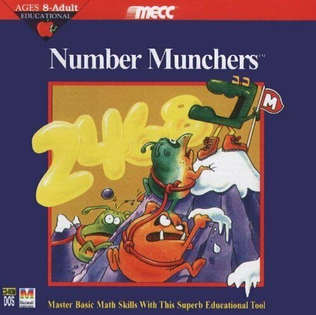Number Munchers facts for kids
Quick facts for kids Number Munchers |
|
|---|---|

DOS Cover art
|
|
| Developer(s) | MECC |
| Publisher(s) | MECC |
| Designer(s) | R. Philip Bouchard |
| Platform(s) | Apple II, DOS, Macintosh |
| Release date(s) | Apple II: 1986 DOS/Mac: 1990 |
| Genre(s) | Educational |
| Mode(s) | Single-player |
Number Munchers is a classic educational video game from 1986. It's like a math adventure! The game was created by a company called MECC. It first came out for the Apple II computer. Later, in 1990, it was also released for DOS and Macintosh computers. The idea for Number Munchers came from Philip R. Bouchard, who also helped create the famous game The Oregon Trail. There were two main versions: one for homes and another for schools. Later, after The Learning Company bought MECC, the game got a new name: "Math Munchers."
Contents
How to Play Number Munchers
In Number Munchers, you control a friendly character called the "muncher." Your goal is to move the muncher around a grid filled with numbers. At the top of the screen, you'll see a special math rule. You need to "munch" (eat) only the numbers that fit this rule.
Avoiding the Troggles
While you are munching numbers, you must also avoid scary monsters called "troggles." These troggles will chase your muncher around the grid. If a troggle catches you, you lose a life!
Game Difficulty and Levels
As you play and complete levels, the game gets harder. The math rules become more complex. You'll also see bigger numbers on the grid. More troggles will appear, making it trickier to avoid them. The game challenges you to think fast and use your math skills.
Learning Math with Number Munchers
Number Munchers was made to help students learn and practice math. It was designed for kids in grades four through eight. Parents could even set the difficulty level at home.
What Math Skills Does it Teach?
This game teaches many important math ideas. You can learn about:
- Multiples: Numbers that result from multiplying a number by another whole number (like 2, 4, 6 are multiples of 2).
- Factors: Numbers that divide evenly into another number (like 1, 2, 3, 6 are factors of 6).
- Prime Numbers: Numbers greater than 1 that only have two factors: 1 and themselves (like 2, 3, 5, 7).
- Equalities: When two things are exactly the same (like 2 + 2 = 4).
- Inequalities: When two things are not equal (like 5 > 3 or 1 < 4).
The game helps younger students learn new math skills. It also lets older students practice what they already know. Teachers could even connect their game to classroom computers. This helped them keep track of student progress. Number Munchers is a fun way to improve your math and quick thinking!

